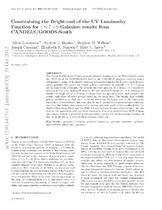| dc.contributor.author | Lorenzoni, Silvio | |
| dc.contributor.author | Bunker, Andrew J. | |
| dc.contributor.author | Wilkins, Stephen M. | |
| dc.contributor.author | Caruana, Joseph | |
| dc.contributor.author | Stanway, Elizabeth R. | |
| dc.contributor.author | Jarvis, Matt | |
| dc.date.accessioned | 2018-02-07T10:18:53Z | |
| dc.date.available | 2018-02-07T10:18:53Z | |
| dc.date.issued | 2013 | |
| dc.identifier.citation | Lorenzoni, S. et al. (2013). Constraining the bright-end of the UV luminosity function for z ~ 7-9 galaxies: results from CANDELS/GOODS-South. Monthly Notices of the Royal Astronomical Society, 429(1): 150 - 158 | en_US |
| dc.identifier.issn | 0035-8711 | |
| dc.identifier.uri | http://dx.doi.org/10.1093/mnras/sts325 | |
| dc.identifier.uri | http://hdl.handle.net/10566/3485 | |
| dc.description.abstract | The recent Hubble Space Telescope near-infrared imaging with the Wide-Field Camera
#3 (WFC3) of the GOODS-South field in the CANDELS program covering nearly
100 arcmin2, along with already existing Advanced Camera for Surveys optical data,
makes possible the search for bright galaxy candidates at redshift z ~ 7 − 9 using
the Lyman-break technique. We present the first analysis of z′-drop z ~ 7 candidate
galaxies in this area, finding 19 objects. We also analyse Y -drops at z ~ 8, trebling the
number of bright (HAB < 27mag) Y -drops from our previous work, and compare our
results with those of other groups based on the same data. The bright high redshift
galaxy candidates we find serve to better constrain the bright end of the luminosity
function at those redshift, and may also be more amenable to spectroscopic confirmation than the fainter ones presented in various previous work on the smaller fields (the
Hubble Ultra Deep Field and the WFC3 Early Release Science observations). We also
look at the agreement with previous luminosity functions derived from WFC3 dropout counts, finding a generally good agreement, except for the luminosity function of
Yan et al. (2010) at z ~ 8, which is strongly ruled out. | en_US |
| dc.language.iso | en | en_US |
| dc.publisher | OUP | en_US |
| dc.rights | This is the pre-print version (From arXiv:1210.8417) of the article published online at: http://dx.doi.org/10.1093/mnras/sts325 | |
| dc.rights | | |
| dc.subject | Galaxy evolution | en_US |
| dc.subject | Galaxy formation | en_US |
| dc.subject | Starburst galaxies | en_US |
| dc.subject | High-redshift ultraviolet | en_US |
| dc.title | Constraining the bright-end of the UV luminosity function for z ~ 7-9 galaxies: results from CANDELS/GOODS-South | en_US |
| dc.type | Article | en_US |
| dc.privacy.showsubmitter | FALSE | |
| dc.status.ispeerreviewed | TRUE | |
| dc.description.accreditation | Web of Science | |

